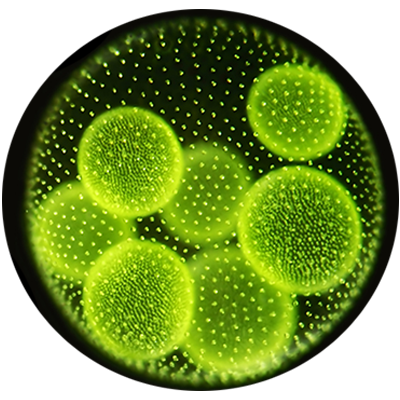OceanTree Technology

Technology : Artificial Photosynthesis
Oceans and water bodies contribute about 76% of the Earth's oxygen through the photosynthesis process carried out by single-celled microalgae and phytoplankton, the unseen lungs of our planet. Inspired by this remarkable natural mechanism, OceanTree has developed a pioneering microalgae-based artificial photosynthesis technology to replicate and enhance this process in urban environments.
OceanTree's artificial photosynthesis system uses specialized LED lighting to simulate sunlight, ensuring optimal wavelengths for microalgae growth and CO₂ absorption, even in indoor or low-light conditions. Our innovation includes a carefully designed nutrient delivery system that provides essential minerals and trace elements to sustain the algae. These nutrients enhance microalgae's metabolic activity, making them healthier, stronger, and capable of maintaining photosynthetic efficiency for up to five times longer than in their natural state.
This breakthrough technology not only removes CO₂ from the atmosphere but also generates pure oxygen efficiently, creating a self-sustaining air purification system. OceanTree’s artificial photosynthesis bridges the gap between nature and advanced science, offering a scalable solution for improving air quality and promoting sustainability in Tier 1 cities and beyond.
The Untold Story of Global Photosynthesis and Its Artificial Evolution
Photosynthesis, often celebrated as nature’s miracle, is the foundation of life on Earth. Yet, the hidden heroes of this process—microalgae and phytoplankton—remain largely unsung. These microscopic organisms, thriving in oceans and water bodies, contribute approximately 76% of the planet’s oxygen supply, far outpacing terrestrial forests. However, their vulnerability to climate change, pollution, and ocean acidification poses a silent but looming threat to global oxygen cycles.
The Fragility of Artificial Photosynthesis
This disruption in the balance of nature is one of the driving forces behind the rise of artificial photosynthesis technologies. As natural systems struggle to maintain equilibrium, scientists have increasingly turned to artificial methods as a solution—not only to capture carbon but to restore and enhance the very processes that keep our planet breathable and habitable. Artificial photosynthesis is now seen as the sole method to prevent the melting of glaciers, as it can actively reduce atmospheric CO₂ and mitigate global warming, which is the primary driver of ice sheet loss.
The Genesis of Artificial Photosynthesis
The dream of artificial photosynthesis was born from the need to tackle two of humanity's greatest challenges: climate change and energy demand. Initially, focused on mimicking the biochemical pathways of plants to convert sunlight into energy or fuel. However, as understanding deepened, microalgae emerged as the centrepiece of innovation. These single-celled organisms possess unparalleled efficiency in capturing CO₂ and producing oxygen, inspiring the development of advanced systems to replicate their behaviour.
With the looming threat of global climate change and the growing challenge of ocean acidification, artificial photosynthesis has become a potential game-changer. By replicating and enhancing natural processes, artificial photosynthesis can help restore balance to the atmosphere by capturing carbon, producing oxygen, and even reducing the acidity of the oceans. It promises not only to address the excess carbon in our atmosphere but also to counteract the negative impacts of acidification, offering a solution that works both in the air and under the water.
OceanTree: A Modern-Day Photosynthetic Revolution
OceanTree takes this evolution a step further. Harnessing the science behind natural photosynthesis, it integrates cutting-edge technology to simulate and enhance this process. By designing specialized lighting that mimics the sun’s optimal spectrum and providing essential nutrients, OceanTree creates an ideal environment for microalgae. Unlike nature, where algae’s lifespan is limited, these systems ensure a fivefold increase in longevity and efficiency, offering a solution tailored to urban air quality challenges.
Artificial Photosynthesis: Beyond Air Purification
While the primary goal of artificial photosynthesis technologies like OceanTree is CO₂ capture and oxygen production, their potential applications are far-reaching. From creating biofuels and bioplastics to supporting life on Mars, these innovations hold the promise of transforming how we approach sustainability and energy.
The Hidden Message of Photosynthesis
At its core, photosynthesis tells a profound story: a delicate balance between life, energy, and the environment. Both natural and artificial photosynthesis remind us of the interconnectedness of all systems on Earth and the need to protect and innovate within these cycles. As artificial photosynthesis advances, it offers not just a technological marvel but a testament to humanity’s ability to learn from and emulate nature’s most ingenious processes. Through these efforts, we may find the solution to some of the greatest challenges facing our planet, offering a sustainable future where both natural and artificial systems work in harmony to restore the Earth's balance.
SEE LESS
Microalgae and Photosynthesis: The Natural Powerhouse
Microalgae are one of the Earth’s oldest and most efficient organisms, responsible for producing up to 76% of the planet’s oxygen. Through the process of photosynthesis, microalgae absorb carbon dioxide (CO₂) from the environment and release oxygen (O₂). This natural process is crucial for maintaining a balanced ecosystem and plays a key role in carbon sequestration. OceanTree harnesses this ancient, powerful process to improve indoor air quality by absorbing excess CO₂ and replenishing the air with fresh, clean oxygen.
Artificial Photosynthesis: The Heart of OceanTree
OceanTree’s core technology mimics the natural photosynthesis process but in a controlled, artificial environment. The system utilizes photobioreactor tubes—specialized containers designed to optimize light exposure for microalgae. Inside these bioreactors, microalgae thrive, absorbing CO₂ from the surrounding air and using it to produce oxygen and biomass. The process is enhanced with LED lighting to simulate sunlight, ensuring the algae receive the energy they need for photosynthesis, even in low-light or windowless spaces.
Energy-Efficient and Sustainable Design
OceanTree's artificial photosynthesis system is designed to be both energy-efficient and sustainable. The photobioreactors consume minimal power, relying on LED lights to mimic natural sunlight, and the algae process the CO₂ in an energy-efficient manner. This makes the system not only environmentally friendly but also cost-effective, with low maintenance and operational costs.

CO₂ Absorption and Oxygen Generation
The system effectively captures excess CO₂ present in indoor spaces, which can lead to health issues like brain fog, fatigue, and respiratory problems. By using microalgae to absorb this CO₂ and release oxygen, OceanTree ensures continuous air purification, improving the indoor environment for both health and productivity.
photosynthsis
